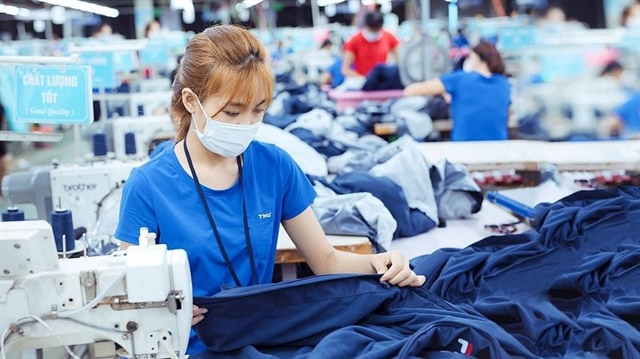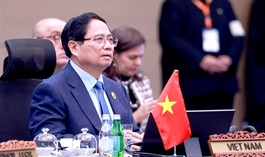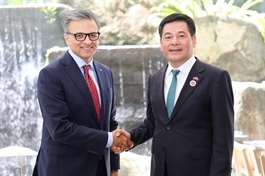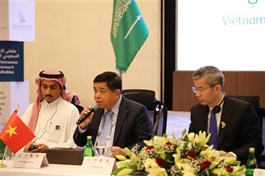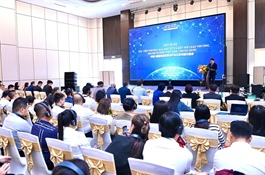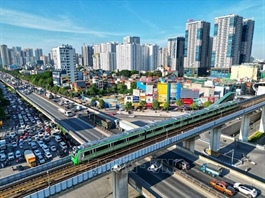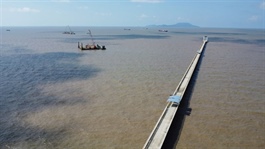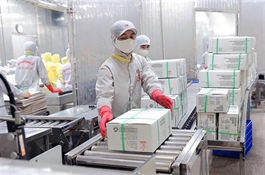HSBC projects Vietnam's GDP growth to reach 7.9 per cent in 2025
HSBC projects Vietnam's GDP growth to reach 7.9 per cent in 2025
HSBC has raised its yearly GDP growth forecast for Vietnam to 7.9 per cent for 2025 (from 6.6 per cent), and 6.7 per cent for 2026 (from 5.8 per cent).
The forecast was highlighted in a report released by HSBC on October 28.
After upside surprises in ASEAN economies’ growth in Q2, strong momentum has continued. This is particularly evident for trade-dependent countries like Singapore and Malaysia, but Vietnam’s magnitude of upside surprise is in a league of its own. Vietnam delivered a significant upside surprise in its Q3 growth, as high as 8.2 per cent on-year, sustaining the strong momentum in Q2. This outperformance easily beat market expectations of 7.2 per cent on-year, placing Vietnam as the fastest-growing economy in ASEAN, once again.

HSBC's new forecasts on Vietnam’s macro indicators |
What surprises HSBC the most is the resilience of the externally oriented industries, and this reflects in manufacturing and trade. Despite an uncertain trade environment, industrial production (IP) grew 10 per cent on-year in Q3. Not surprisingly, trade continues to boom with exports and imports both hitting close to 20 per cent on-year growth. But what is more encouraging is the trade surplus Vietnam has retained, which has more than doubled to $3 billion in Q3, from the first half of 2025. This indicates Vietnam has widened its trade surplus with trading partners other than the US, although the latter remains its biggest exporting destination with one-third of the total share.
A closer look at the data reveals the main driver of trade: electronics products. The strong momentum is observed in both consumer electronics and electronics components. This boosts Vietnam’s exports to the US significantly, with exports still hitting almost 30 per cent on-year in Q3. While frontloading trade activities have peaked across ASEAN, Vietnam’s export growth to the US market remains elevated, reflecting another trend we have been witnessing across Asia: that tech-exposed economies are benefiting from high AI-driven tech demand, providing a hard backbone for their trade.
In addition to trade resilience, the services sector continues to see strong growth. Consumer-oriented retail sales are seeing some meaningful improvements, finally. Retail sales jumped 12 per cent on-year in Q3, narrowing the gap with its pre-pandemic trend to only 3 per cent, from 10 per cent at the start of 2025.
Meanwhile, tourism-related sectors, including transport and accommodation, are also seeing an ongoing boom. In last month’s commentary, HSBC outlined how Vietnam has now turned into the new darling for Chinese tourists, despite not having a visa-free scheme. Indeed, Vietnam is leading ASEAN in tourism recovery. After welcoming 15 million tourists as of Q3, Vietnam is seeing the return of tourists equivalent to 120 per cent of 2019’s level. While Vietnam does not rely on tourism as much as peers such as Thailand, its rising competitiveness in tourism nonetheless partially shields it against the trade headwinds.
Apart from the supply side of the economy, it is equally important to assess the demand side. Real consumption expanded over 8 per cent on-year, while real investment grew close to 10 per cent on-year in Q3. In particular, the focus on accelerating mega infrastructure projects has been a priority. That said, there is still room to expand further, as the disbursement rate of public investment is only 50 per cent of the annual target as of Q3.
|
In addition to public investment, foreign direct investment (FDI) remains a key driver in fuelling Vietnam’s growth. Since the US “liberation day” in April, there have been increasing concerns on the sustainability of Vietnam’s FDI inflows. Total FDI rose 15 per cent on-year as of Q3, but new registered FDI fell 9 per cent on-year. Interestingly, the composition of Vietnam’s FDI portfolio has shifted this year. In 2024, Singapore, Korea, and mainland China were the top-three investors.
However, Singapore and mainland China now account for around a quarter of new FDI, respectively, while Korea’s share has dwindled, with the US filling the gap. In other words, despite trade uncertainties, the world’s two largest economies continue to pour their investments into Vietnam. After all, now that all ASEAN emerging markets are back to the same starting line, facing tariffs of 19-20 per cent, existing beneficiaries of the trade tensions will continue to benefit, for example, Malaysia and Vietnam.
Outside of growth, inflation remains largely in check. Despite a modest pick-up in momentum of 0.4 per cent on-month, headline inflation rose 3.4 per cent on-year in September, in line with market expectations. The main drivers were rising food prices, due to increasing demand during the National Day holidays, and increasing petrol prices. Core inflation remains stable at 3.2 per cent on-year, well below the State Bank of Vietnam (SBV)’s 4.5-5 per cent inflation ceiling.
With inflation taking a back seat, the SBV is aiming for higher credit growth to support growth. Credit growth has seen a spike to 20 per cent on-year at the end of August, on track with the SBV’s expectation of annual expansion of 19-20 per cent, higher than its original target of 16 per cent.
- 09:52 29/10/2025


